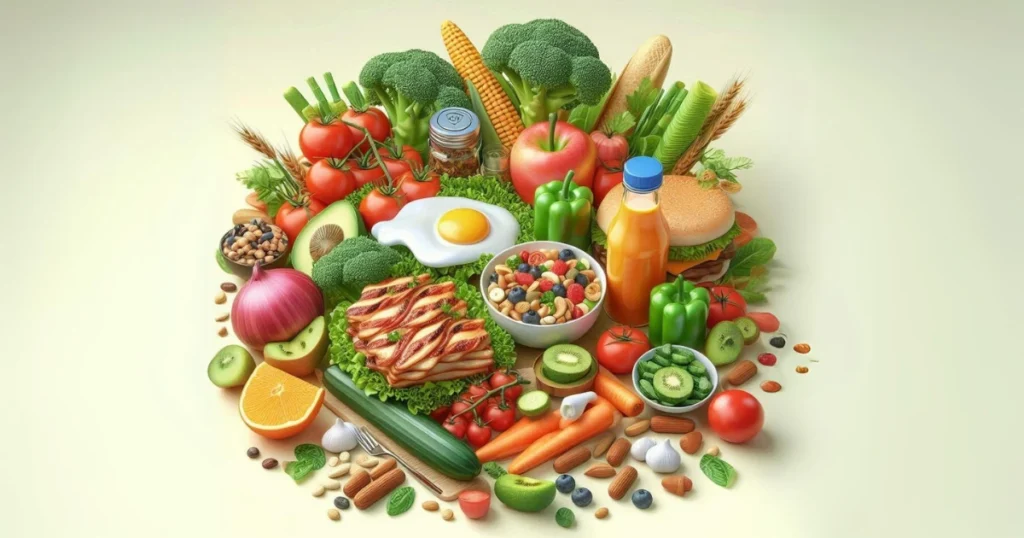
In today’s busy world, it can be hard to stick to a healthy diet, especially if you’re trying to save money. But eating healthy food doesn’t have to cost a lot of money. You can eat tasty, healthy foods without spending a lot of money if you plan ahead and shop smart. This complete guide will give you many cheap and healthy meal ideas, as well as tips on how to shop for groceries without breaking the bank and Maximize your nutrient consumption while minimizing expenses.
How can you eat cheap healthy meals on a tight budget?
1. Budget-friendly nutrition
Nutrient-dense foods contain a significant amount of essential nutrients relative to their calorie count. Fruits, veggies, whole grains, lean proteins, and healthy fats are some of the most important foods for a healthy diet. If you focus on nutrient-dense foods, you will get the most nutrients for your money.
Creating a Balanced Meal Plan
Planning ahead is very important if you want to save money at the grocery store.
Choose one day per week to plan your meals for the next seven days. Then, write down everything you need to buy at the store to make those meals.
Kindly examine your fridge and cabinets to identify the items that are already in your possession. You might have food in the back that you can use or plan meals around foods you need to eat soon.
You should only buy things you are sure you will use. This way, you won’t waste a lot of the things you buy but don’t use.
A well-balanced meal plan includes a variety of foods from all the major food groups. Aim to incorporate:
- Fruits and Vegetables: Fresh, frozen, or canned options are all viable.
- Whole Grains: Brown rice, quinoa, whole-wheat pasta, and oats.
- Proteins: Beans, lentils, eggs, chicken, and fish.
- Dairy or Dairy Alternatives: Low-fat milk, yogurt, and plant-based options.
Planning your meals ahead of time helps avoid impulse purchases and reduces food waste, both of which can save you money.
2. Smart shopping strategies
- Making a Shopping List: Make a shopping list first. A well-thought-out list can help you stick to your budget and keep you from buying things you don’t need. Write down everything you need to make the meals you’d like to eat this week.
- Buying in Bulk: When you buy things in bulk, you can save a lot of money. When you buy more of certain foods, like rice, pasta, beans, and oats, the price per unit is usually cheaper. To keep these things fresh, just make sure you have a good place to store them.
- Seasonal and Local Produce: Fresh fruits and veggies that are in season cost less and taste better. To get the best deals on fresh food, go to farmers’ markets or join a community-supported agriculture (CSA) program.
- Cheap Brands and Sales: Instead of name brands, choose shop brands. Most of the time, generic items are just as good as brand-name ones, but they cost a lot less. Take advantage of sales, deals, and coupons to save even more money.
3. Maximizing nutrition on a budget
- Cook at Home: Cooking meals at home is typically more cost-effective and better for your health compared to dining out. If you shop around, you can feed a family of four for the same price as two or one person at a restaurant. Instead of going out to eat at the last minute, make it a habit to cook at home. You have control over the ingredients and can avoid added sugars, salts, and unhealthy fats.
- Batch Cooking and Freezing: Prepare meals in huge quantities and then freeze portions of them. This not only helps you save time but also guarantees that you will always have a nutritious lunch ready to go, which will reduce the temptation to order takeout.
- Using Leftovers Creatively: Making Use of Excess Food In order to produce new meals, you can creatively repurpose leftovers. For instance, you can incorporate leftover roasted veggies into a salad or a frittata.
- Incorporating Plant-Based Proteins: Plant-based proteins, like beans, lentils, and tofu, offer a variety of nutrients and are typically more affordable than meat. Furthermore, their extended shelf life reduces the possibility of food waste.
4. budget-friendly grocery list
Here’s a sample grocery list that balances affordability and nutrition:
- Grains: Brown rice, whole wheat pasta, oats, quinoa
- Proteins: Eggs, beans, lentils, canned tuna, and tofu
- Vegetables: Carrots, spinach, broccoli, potatoes, canned tomatoes
- Fruits: Apples, bananas, oranges, and frozen berries
- Dairy: Low-fat milk, yogurt, and cheese
- Pantry Staples: Olive oil, spices, canned beans, peanut butter
5. Tips for reducing food waste
- Proper Storage: Properly storing food will allow it to have a longer shelf life. For example, consider the practice of storing dry items in airtight containers and fruits and vegetables in the crisper drawer of the refrigerator.
- First In, First Out: Rearrange the items in your refrigerator and pantry so that the more recent ones are in the back and the older ones are in front. We encourage you to utilize your current inventory before making new purchases.
- Understand Expiration Dates: Many foods remain edible even after their “best by” date has passed. You can decide whether or not a food item is still edible by using your senses (smell, taste, and sight).
6. Grow your own produce
It’s best to grow your own food or join a community farm if you can. It’s not expensive to buy seeds. You might be able to grow your own herbs, sprouts, peppers, onions, and many other tasty foods if you put in some time and work.
You can save money at the store by having a steady supply at home. Also, fruits and vegetables grown at home might taste much better than those bought in stores. You can also be sure that it was picked when it was at its ripest.
7. Affordable and nutritious meal ideas
Breakfast
- Oatmeal with Fresh Fruit: Oats are inexpensive and packed with fiber. Top with seasonal fruits for added vitamins and minerals.
- Egg Muffins: Mix eggs with chopped vegetables and bake in a muffin tin. These are great for a quick, protein-rich breakfast on the go.
Lunch
- Quinoa Salad: Mix cooked quinoa with chopped veggies, beans, and a straightforward dressing. The outcome is a hearty and nourishing lunch option.
- Vegetable Soup: Use a variety of vegetables, some broth, and spices to create a hearty soup. Freeze portions for easy lunches throughout the week.
Dinner
- Stir-Fry: Use seasonal vegetables, tofu or chicken, and a simple sauce. Serve over brown rice or noodles.
- Chili: A pot of chili made with beans, tomatoes, and spices is both filling and cost-effective.
Snacks
- Homemade Trail Mix: Mix nuts, seeds, and dried fruit for a wholesome snack option.
- Yogurt with Honey and Nuts: A quick and healthy option that’s rich in protein and healthy fats.
The bottom line
If you want to eat well, you don’t have to spend a lot of money. In fact, even on a very limited budget, there are numerous ways to consume meals that are rich in nutrients.
Among these are meal planning, meal preparation at home, and nutritious food selection at the supermarket.
Additionally, keep in mind that the cost of highly processed goods is twice as high.
This is because consuming a large quantity of meals high in sodium or sugar can lead to a variety of health concerns. It is possible that you will not be able to work as much as you did in the past due to these occurrences, which come with expenses for medical care or medication.
Even if the cost of consuming foods that are rich in nutrients were to be higher—there is no requirement for this to be the case—it would still be beneficial in the long run. Putting a monetary value on your health is simply not possible.


